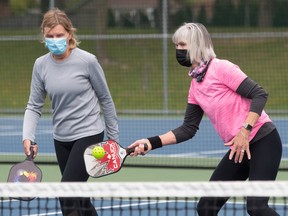When fun and fitness are on the same stage, not only will participation increase, but compliance will also increase.

Postmedia is done from the link on this page You may earn affiliate commissions from your purchases.
Pickleball, which claims to be the fastest growing sport in North America, outperforms most other sports.
Pickleball CanadaAccording to a 2022 survey, the number of players has tripled in two years, with at least 8% of Canadian households. One household member reports playing. Pickleball is once a month. This means that about 1 million Canadians play pickleball, 45% of whom play more than four times a month.
The baby boomer generation was part of the early adopters of the sport, but the number of 18-34 year olds participating in the game is steadily increasing. Fun and fitness are often cited as reasons why many people have a racket. It is worth knowing how much training you will get during a pickleball game.
A hybrid of tennis, badminton and table tennis, pickleballs are played on 6.10 x 13.41 meters (20 x 44 feet) courts, and the majority of recreational players prefer doubles to singles. It's a smaller court than tennis, so pickleball players don't have much room to cover. This is a great game for those who have taken the time to slow down by a step or two. However, few studies have investigated how pickleballs contribute to overall fitness because of the newness of the sport.
A team of American researchers at the University of Western Colorado has given eight women and seven men between the ages of 40 and 85 the amount of energy they consume during the game. Equipped with a portable unit designed to determine. Pickleball. They also took snapshots before and after the health of cardiac metabolism to see if pickleball had a positive effect on their fitness and health after 6 weeks of regular play.
A group of researchers at Brigham Young University in Idaho wanted to investigate the physiological requirements of the game and find a comparison between a 30-minute double pickleball and a 30-minute walk. They gather 25 pickleball players (15 men and 10 women) with an average age of 38 and measure heart rate, steps, and calories burned while walking or playing pickleball. Equipped with.
Both studies confirmed that pickleball is a legitimate training. A study picker in western Colorado burned 353.5 calories per game with an average heart rate of 108 beats per minute. This is categorized as moderate intensity training.
"Regular participation in pickleball induces cardiovascular and metabolic responses that meet exercise intensity guidelines for improving and maintaining cardiovascular health," the researchers say. ..
Fifteen men and women also improved their health and fitness during the course of their studies and needed to play an hour of pickleball (about four doubles matches) a day.
"After 6 weeks of participation in Pickles Ball, we saw significant improvements in the following results: high density lipoprotein (HDL) and low density lipoprotein (LDL) cholesterol, systole and diastole. "Systolic blood pressure and maximum oxygen uptake," the researchers said.
Regarding the comparison between pickleball and walking, subjects in the Brigham Young study recorded 14% higher heart rate and 36% higher calorie consumption compared to walking. Did. They said pickleball felt more like training than walking.
"Playing pickleball doubles felt more intense than walking. The median perceptual movement after pickleball doubles was nearly 44% higher than the median perceptual movement after walking. That's why, "said Brigham Young researchers. ..
However, in terms of steps, a 30-minute walk recorded 54% more steps than a doubles game. With smaller courts and nearby teammates on the same side of the net, much of the play done on the net means less steps are accumulated during the match.
These statistics are interesting, but there are some caveats. Researchers in western Colorado pointed out that there was considerable variability among subjects. Some heart rates also indicate that the individual is playing well within range. It is considered intense training. Also, some individuals consume less energy than the average pickleball player and may be playing on the other side of the intensity range.
Brigham Young's research subjects found pickleball to be more fun than walking. This is a sentiment echoed by respondents to the Canadian Pickleball Survey. 62% of the surveyed people say that the main reason for playing pickleball is because it's fun. This increased to 89% among baby boomers.
That sense of fun is the reason for the surge in participation in pickleball leagues and nearby courts across the country. When fun and fitness are on the same stage, not only will participation increase, but adherence will also increase. People come back for fun more often than exercise. Even among Canadian pickers, the social aspect of the game is important. That's why 38% of survey respondents said they were in court.
This is all good news for Canadian pickle ball players spending the summer on the court. They are having fun in the sun and are in good physical condition.
-

Fitness: Gyms need to welcome people of all sizes, not just one size fits all
-

Fitness: Start your workout with a glass of Joe

Sign up for daily headline news from Montreal Gazette, a division of Postmedia Network Inc.
Thank you for registering.
A welcome email has been sent. If you don't see it, check your junk folder.
The next issue of Montreal GazetteHeadlineNews will soon arrive in your inbox.


